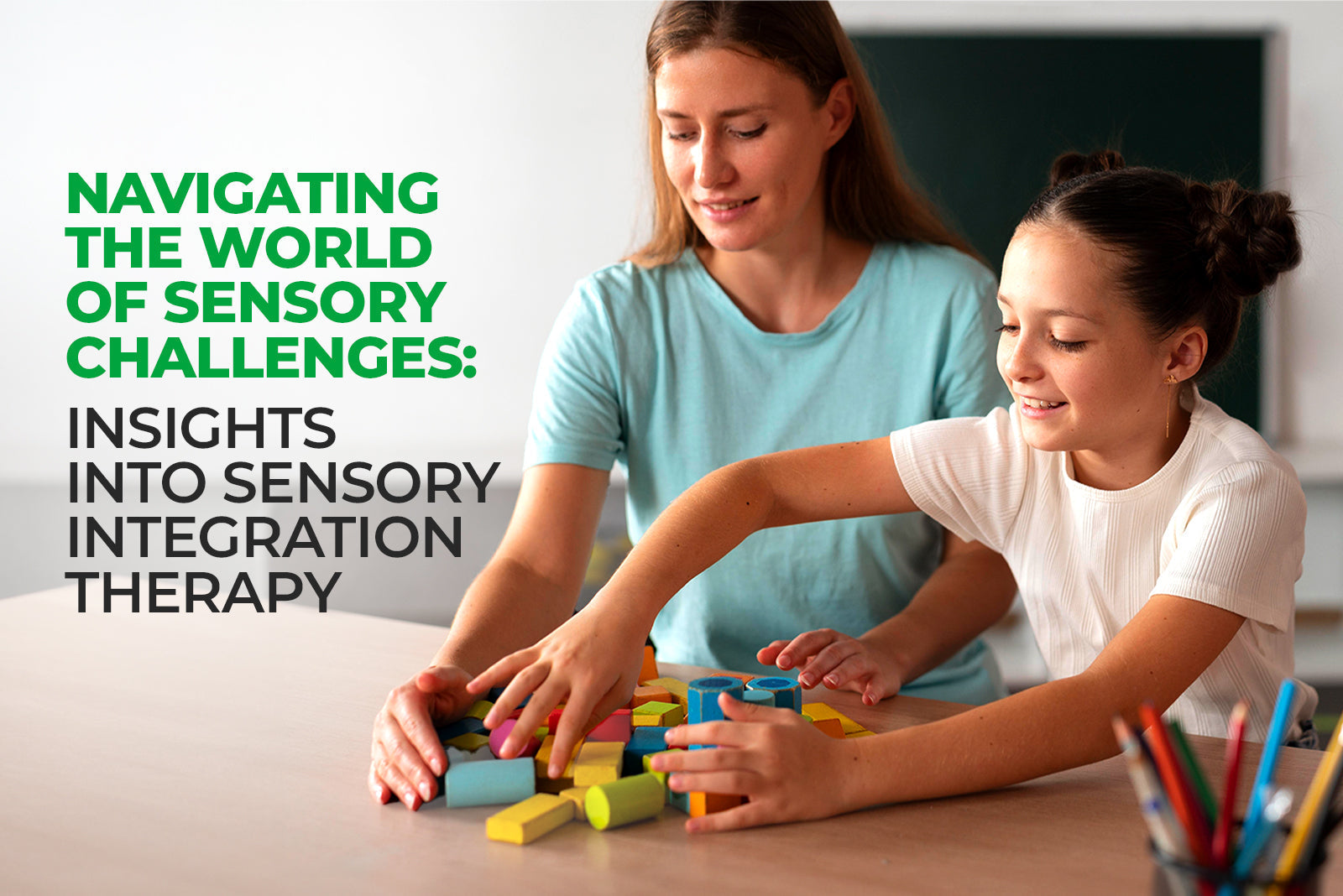Navigating the World of Sensory Challenges: Insights into Sensory Integration Therapy

Imagine a world where every sound, touch, or flicker of light isn't just noticed, but felt with an intensity that can be breathtaking or overwhelming
—where the ordinary hum of daily life becomes a symphony of sensations. For children on the autism spectrum, this is their reality. Sensory challenges transform routine experiences into daunting tasks, shaping how they perceive and interact with the world around them.
From the soft rustle of leaves to the glare of fluorescent lights, each sensory input can evoke a response that varies dramatically from what neurotypical individuals might experience. These sensory processing differences can make it difficult for autistic children to navigate and respond appropriately to their environment. Everyday stimuli that seem mundane to us can provoke discomfort or even distress for them.
In this blog, let’s understand the nuances of how sensory integration therapy works, its challenges, and much more.
Understanding Sensory Integration Challenges:
Sensory processing disorder affects many autistic individuals, altering how they interpret and respond to sensory inputs.
What might be a minor distraction to some can be distressing to others with sensory issues. These differences make it crucial to address sensory integration—the brain’s ability to organize and interpret sensory information.
For individuals with sensory processing disorder, the world can feel like an unpredictable array of sensations. Sounds that seem normal to others may echo loudly in their ears, textures may feel uncomfortably rough or slimy, and lights can be blindingly bright.
These sensitivities can lead to anxiety, avoidance behaviors, and difficulties in social interactions. By focusing on sensory integration, therapies like sensory integration therapy aim to help individuals better regulate these responses, enabling them to engage more comfortably and confidently in daily life.
Exploring Sensory Integration Therapy:
Sensory integration therapy, pioneered by Occupational Therapist Jean Ayres in the 1970s, aims to alleviate these challenges.
This therapy recognises that with the right approach, the nervous system can adapt and integrate sensory inputs more effectively. It provides a structured environment where children can explore various sensory stimuli in a safe and supportive manner.
At its core, sensory integration therapy seeks to create a therapeutic environment where children can engage in activities specifically designed to challenge and stimulate their sensory systems.
These activities are carefully chosen to target areas of sensory difficulty, such as sensory seeking or sensory avoidance behaviors. By gradually exposing children to these stimuli in a controlled setting, therapists help them build tolerance and develop adaptive responses.
This approach not only enhances sensory processing but also promotes overall emotional regulation and cognitive development.
The Core of Sensory Integration Therapy:
At the heart of this therapy lies the creation of sensory-rich environments. Here, children engage in purposeful activities designed to stimulate and integrate their senses.
Whether through swinging, climbing, tactile play, or balance exercises, each activity targets specific sensory systems, fostering better sensory processing and regulation.
These sensory-rich activities are more than just play—they are carefully structured interventions that aim to rewire the brain's responses to sensory stimuli. By engaging in activities that challenge their sensory thresholds, children learn to interpret sensory information more accurately and respond in ways that are adaptive and appropriate.
This process not only enhances their ability to engage with their environment but also improves their overall quality of life by reducing sensory-related stress and anxiety.
How Therapy Unfolds:
Skilled therapists play a pivotal role in guiding these sessions. They employ specialised techniques tailored to the unique needs of each child, fostering skills such as motor planning, coordination, and spatial awareness.
Through consistent engagement in these activities, children learn to regulate their responses to sensory stimuli, enhancing their overall sensory processing abilities.
Beyond Therapy Sessions:
The benefits of Sensory Integration Therapy extend far beyond the therapist's office. Parents and caregivers are encouraged to incorporate sensory activities into daily routines, creating a supportive home environment.
Including sensory activities into daily life helps reinforce the skills learned in therapy sessions and promotes ongoing sensory integration. Simple activities such as sensory bins, movement breaks, or calming routines before bedtime can provide opportunities for children to practice self-regulation and sensory modulation skills in familiar settings.
By integrating these activities into daily routines, parents and caregivers play a crucial role in supporting their child's progress and fostering a sensory-friendly environment that promotes overall well-being.
Conclusion:
In essence, Sensory Integration Technique/Therapy is not just about managing challenges—it's about empowering children to thrive amidst sensory diversity. Each child's journey is unique, requiring patience and empathy. As you embark on this path, remember that every small step forward is a triumph worth celebrating.
If you feel your child may benefit from Sensory Integration Treatment, consult with your child’s healthcare provider. At Nisarga Herbs, we understand the importance of holistic approaches to health. Our ayurvedic brain syrup complements therapies like Sensory Integration Therapy, providing natural support for cognitive and sensory health.
By embracing sensory diversity and leveraging therapies like Sensory Integration Therapy alongside natural remedies, we can create nurturing environments where every child can flourish.
FAQ
Question 1: What is Sensory Integration Therapy and how does it help my autistic child?
Answer: Sensory Integration Therapy is a type of occupational therapy that helps children with sensory processing challenges. For autistic children, it helps them better respond to sounds, touch, lights, and other sensory inputs. Through structured play and activities, it teaches their brain to process and react to sensory information in a more balanced way.
Question 2: How do I know if my child needs Sensory Integration Therapy?
Answer: If your child is highly sensitive to sounds, avoids touch, gets overwhelmed in bright or noisy environments, or seeks unusual sensory input (like spinning or crashing into things), they may benefit from this therapy. A professional evaluation by an occupational therapist can confirm whether it’s suitable.
Question 3: Can Sensory Integration Therapy be done at home?
Answer: Yes, many sensory activities can be done at home with guidance from a therapist. Simple tasks like playing in a sensory bin, jumping on a trampoline, or swinging can help. Consistency and structure are key. Your therapist can create a customized home plan.
Question 4: How long does Sensory Integration Therapy take to show results?
Answer: Each child is unique, so results vary. Some children show improvement in a few weeks, while others may take several months. Consistent therapy and home reinforcement usually lead to the best outcomes. Progress is often gradual but meaningful.
Question 5: Is Sensory Integration Therapy backed by science?
Answer: Sensory Integration Therapy was developed by Dr. Jean Ayres in the 1970s and is supported by decades of clinical use. While more research is ongoing, many parents and therapists report significant improvements in sensory regulation and daily functioning.
Question 6: What role do parents play in sensory integration therapy?
Answer: Parents play a vital role. By continuing sensory activities at home and supporting the child’s routines, they reinforce what is learned in therapy. Parents also help monitor progress and communicate with the therapist for adjustments.
Question 7: Can Ayurvedic remedies like brain syrups help along with therapy?
Answer: Yes, natural remedies like Ayurvedic brain syrups may support cognitive and sensory health when used alongside professional therapy. Always consult your child’s doctor or therapist before adding supplements to their routine.
Question 8: What’s the difference between sensory seeking and sensory avoiding behavior?
Answer: Sensory seekers crave intense sensory input—like spinning, jumping, or loud noises. Sensory avoiders are overly sensitive and may cover their ears, avoid touch, or resist certain clothes or foods. Sensory Integration Therapy addresses both patterns.


 Mental Wellness
Mental Wellness
 Vital Organ Wellness
Vital Organ Wellness
 Skin Wellness
Skin Wellness
 Immunity Wellness
Immunity Wellness
 Sexual Health
Sexual Health
 Bones Wellness
Bones Wellness
 Daily Wellness
Daily Wellness
 Kids Wellness
Kids Wellness
 Diabetes Wellness
Diabetes Wellness



